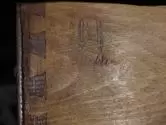New Stickley Book Solves Many Mysteries
 The Manufacture of Arts & Crafts Furniture by Gustav Stickley
The Manufacture of Arts & Crafts Furniture by Gustav Stickley
W. Michael McCracken, author
Turn of the Century Editions / Parchment Press
(Softcover, 326 pages, $45, 2012)
To say that Michael McCracken has an obsession for the furniture of Gustav Stickley would be putting it mildly.
To his credit, this Georgia Tech professor is equally as obsessed with sharing everything he has learned about how Gustav Stickley designed, manufactured, fumed, dyed and finished his Arts & Crafts furniture. Through his articles, his Grove Park Inn seminars and annual discussion groups, and now, through the most analytical book on this subject, Michael has opened the doors to the Stickley factory and let us in.
Systematic in his organization, Michael carefully lays the groundwork for revealing his discoveries by explaining precisely how furniture was both manufactured and finished before and during the Arts & Crafts era. And while it no longer exists, he then takes us on a virtual tour of each floor of the former Craftsman furniture factory which once stood on the outskirts of Syracuse.
While other authors have been stymied by Stickley’s own vague descriptions how Craftsman furniture was fumed, dyed and finished, Michael cuts through the generalities and often misleading statements swirling over the subject to analyze and dissect the process by which the workmen in his factory achieved the famed Stickley finish.
Once and for all, Michael has also researched and analyzed just how Arts & Crafts furniture was fumed, why it was fumed and why, near the close of the era, even Gustav Stickley stopped fuming his furniture. He answers the question of when lacquer began replacing shellac as the preferred finish, and, for those who are so inclined, includes recipes for duplicating Arts & Crafts finishes.
The book is amply illustrated with both color photographs of Craftsman furniture, as well as historic photographs and detail close-ups of various colors achieved through the fuming and dyeing process.
And just as you would expect from a university professor schooled in research and documentation, Michael unearthed each of his discoveries through hours of meticulous research, personal interviews and close inspection of hundreds of pieces of Stickley furniture, often with a magnifying glass and long-wave ultraviolet fluorescent light in hand.
If you have ever wondered just what role machinery played in the production of Arts & Crafts furniture, whether the original finish you are admiring is varnish, shellac, wax or lacquer, how Gustav Stickley organized his factory and his workers to produce so many different forms, from small tabourets to massive director’s tables, then this book is one you should own.
One warning: this is not a mass-produced book. Publishers Peter and Janet Copeland of Turn of the Century Editions brought a modest number of copies to the Grove Park Inn Arts & Crafts Conference in February and sold out quickly. Given the financial investment and risks authors and publishers must take to get a niche book into print, this book may only be available in small quantities and may soon slip into that category of “Wish I had bought one when I had the chance.”
This is your chance.
Don’t let it slip away.
http://www.turnofthecenturyeditions.com
– Bruce Johnson

